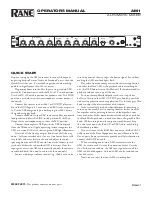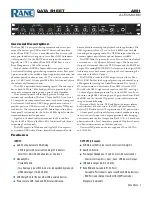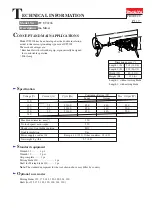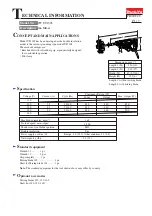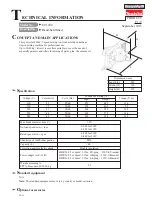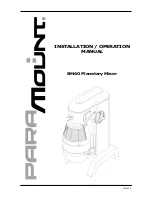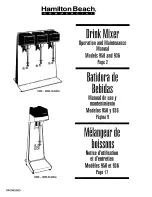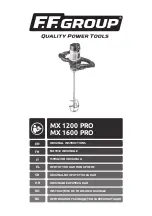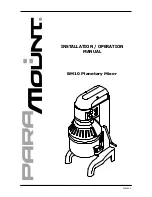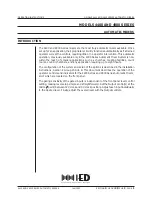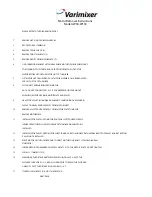
Manual-5
MIC INPUTS
The rear panel, three-position Mic/Line switches set the mic
input gain such that the maximum signal permitted almost clips
the A/D converter. This is true for each switch position. The Mic
Inputs are automatically mixed using a gain-sharing algorithm.
Set the inputs using the black knobs so they do not (or rarely)
clip. Then, sit back and relax. If you’ve already set up the inputs
and someone starts talking louder/closer than you expected, feel
free to turn them down a little.
The green Signal indicators should easily light for soft talk-
ers even at relatively low Level settings. The Overload indicator
should light only occasionally for only the loudest talkers.
The gray Mic Mix knob adjusts the level of the automatic
mix of all Mic Inputs. Use it to change the mix of all the Mics
relative to the Aux 1, Aux 2 and USB Audio Line Inputs. Even
when multiple Rane AM2 Automixers are cascaded into an AM1
providing additional microphones, the Mic Mix knob on the
AM1 still adjusts the overall mix of all microphones – up to 60
mics when using seven AM2s. The Overload indicator adjacent
to the Mic Mix knob indicates that the mix of all mics is getting
too loud for the internal circuitry. It can light occasionally, but
only during the loudest talking.
Since these Mic Inputs and their underlying gain-sharing au-
tomix algorithm are designed and optimized for speech signals,
do not use these Inputs with non-speech audio signals such as
musical instruments or CD/DVD.
AUX INPUTS
The two Aux Inputs are designed for iPod®/MP3 players, CD/
DVD players, et cetera. Since the AM1 mix is mono, audio
at these two stereo inputs is monoed upon entering the AM1.
Adjust the front panel Aux Level controls for Aux 1 and Aux 2
to set the relative mix of these sources. The Overload indicators
light when the incoming audio is getting too loud. Only the very
loudest audio sources should occasionally light the Overload
indicator.
If you’re using an iPod® or other aux/line source that allows
output volume adjustments, turn the volume up as far as possible
without lighting the Overload indicator too often.
MIXING
The Mic Inputs are automatically mixed. Use the four gray Mix
knobs to adjust the relative volume of the four inputs: Mic Mix,
Aux 1, Aux 2 and USB Audio from the PC. The red overload
indicators should light only when the loudest source sounds are
running at full-tilt boogie.
OUTPUTS
All the AM1 audio outputs, digital and analog, contain a mono
mix of the automatically mixed Mics and manually mixed Line
Inputs from the four gray Mix knobs.
RECORD OUTPUT
The level or volume of the Record Output is not altered by the
AM1’s front panel Output level control. This permits consistent
recording levels on your favorite recording device, while adjust-
ing the volume in the room / PA system.
MAIN OUTPUT
The front panel Output Level control adjusts the level of this
output.
HEADPHONE AND CUEING
Plug in headphones and adjust the Phones Level knob to a com-
fortable volume. All headphone audio is mono – just like all the
other AM1 outputs.
The Source knob allows cueing each mix source indepen-
dently. This allows verification that a source is working properly
before bringing it into the mix.
With the Source set to Output, the entire mix is heard. Use
the four gray Mix knobs to adjust the relative volume of each
source. Select Mic Mix to hear the automatic mix of all micro-
phones in the system. Select Aux 1, Aux 2 or USB to hear each
of these inputs individually.
Use only one of the headphone jacks at a time.
AM1
AUTOMIXER
POWER
LOCATE
PHONES
MIX
SIG
OL
SIG
OL
LEVEL
SIG
OL
LEVEL
SIG
OL
LEVEL
MIC MIX
SIG
OL
LEVEL
AUX 1
SIG
OL
LEVEL
AUX 2
SIG
OL
LEVEL
USB
SIG
OL
LEVEL
OUTPUT
SIG
OL
LEVEL
AUX 2
AUX 1
USB
MICS
OUTPUT
SOURCE
LEVEL
LEVEL
MIC INPUTS
1
2
3
4
OPERATION

